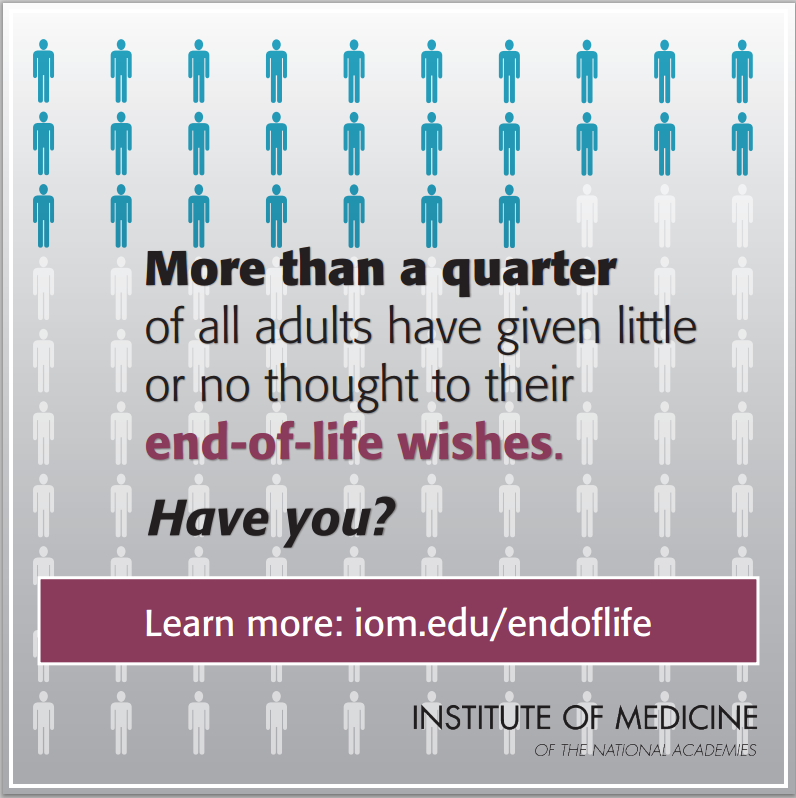
by: Alex Smith @alexsmithMD
I’d like to draw GeriPal readers’ attention to the new report issued by the Institute of Medicine titled, “Dying in America: Improving Quality and Honoring Individual Preferences Near the End of Life.”
This report represents the culmination of a huge amount of work by incredibly smart people. Many of these people we know well, including Diane Meier, James Tulsky, Bernie Lo, Jean Kutner, Christian Sinclair. Other folks contributed in different ways, like Amy Kelley and Melissa Aldridge who wrote a commissioned paper, and Susan Block, Betty Farrell, VJ Periyakoil, and Joanne Wolf who contributed to reviewing the draft.
The last report, “Approaching Death: Improving Care at the End of Life” was published in 1997, and served as a major road map for improving palliative and hospice care in this country.
I will use this brief post to review some preliminary thoughts, having read through the summary materials available on the IOM website. I have only started to dive into the full report (available for download for free). I will follow up with a longer post or perhaps series of posts as I make my way through the full report (while studying for Int Med boards!).
Early points to consider:
- This report has already generated a considerable amount of press. Christian Sinclair is keeping a running tally on his Pallimed post here. It remains to be seen – how much will this report reshape and redirect the national conversation about dying in America? I’m hopeful.
- Most of the hot press focuses on how our health care system is broken, and not serving the needs of dying patients. This is a frame/spin that has the potential to gain traction.
- The framing for the preface and introduction hits home the timeliness of this report in the face of the “death panels” furor, and subsequent stripping from the Affordable Care Act of proposed Medicare payments to doctors for advance care planning conversations.
- Despite sustained efforts to change the public narrative about palliative care from one about dying to one about living with serious illness, including a terrific piece in the WSJ by Diane Meier, this task force and publication is still about dying and end-of-life care. Perhaps the next report will be tasked to examine care for persons with serious illness, rather than end of life care.
- The authors made an important choice in the framing of one strong leading section about optimal care being “Patient-centered and family oriented care.” This is a great frame and thoughtful word choice. It’s just not possible to have both the patient and the family be the unit of care – too many times their goals and preferences are at odds. This phrasing allows for focusing on the patient within the context of the family. Nice.
- Geriatric palliative care is a major focus of the report. They note in all summary materials that dying in America is increasingly characterized by a long term progression of chronic conditions and frailty associated with aging. Recommendations include greater integration of medical and social services (and payment for such), support for caregivers, and ramping up of palliative care services in nursing homes and home-based care programs.
- Prognosis is a major focus, with several mentions of ePrognosis.
- Advance care planning and preparation for in-the-moment decision making is a strong focus, with an emphasis on improving the quality of patient-clinician interaction (and reimbursement!).
- The brief summary statement starts with a concern about unequal distribution of services and hints at disparities by race/ethnicity. I’m looking forward to reading more about this important area as disparities don’t seem to be getting as much attention as other areas in the press about the report.
- The recommendation to move away from fee-for-service medical care is probably the most ambitious recommendation I’ve read about so far.
More to follow, please give your initial impressions in the comments!



